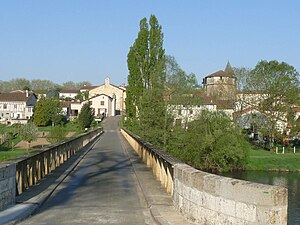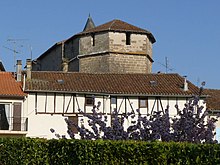Ansac-sur-Vienne
|
Ansac-sur-Vienne Ançac |
||
|---|---|---|
|
|
||
| region | Nouvelle-Aquitaine | |
| Department | Charente | |
| Arrondissement | Confolens | |
| Canton | Charente-Vienne | |
| Community association | Charente limousine | |
| Coordinates | 46 ° 0 ′ N , 0 ° 39 ′ E | |
| height | 130-231 m | |
| surface | 30.79 km 2 | |
| Residents | 829 (January 1, 2017) | |
| Population density | 27 inhabitants / km 2 | |
| Post Code | 16500 | |
| INSEE code | 16016 | |
 Ansac-sur-Vienne - town view |
||
Ansac-sur-Vienne ( Occitan : Ançac ) is a place and a western French community with 829 inhabitants (at January 1, 2017) in the Charente in the region Nouvelle-Aquitaine ( France ). The community consists of several hamlets ( hameaux ) and individual farmsteads .
location
The place Ansac lies on the west bank of the river Vienne at an altitude of about 140 m above sea level. d. M. approx. 61 km (driving distance) northeast of Angoulême in the old cultural landscape of the Angoumois , part of the Charente . The small town of Confolens is only about three kilometers northeast.
Population development
| year | 1800 | 1851 | 1901 | 1954 | 1999 | 2013 |
| Residents | 856 | 975 | 1.002 | 760 | 852 | 856 |
The largely continuous population decline in the 20th century is essentially a consequence of the loss of jobs due to the phylloxera crisis in viticulture and the generally increasing mechanization of agriculture .
economy
In earlier centuries the inhabitants lived on the produce of their fields and gardens as self-sufficient ; cattle breeding was also carried out on a small scale. Viticulture has been promoted in the Charente since the end of the Middle Ages, but it never reached its previous level after the phylloxera crisis. Instead, people returned to agriculture and livestock. Agriculture, handicrafts and retail trade still play the largest role in the town's economic life. Some of the vacant houses are designated as holiday homes ( gîtes ).
history
Ansac-sur-Vienne was on the Roman road from Burdigala ( Bordeaux ) via Ecolisma ( Angoulême ) to Avaricum ( Bourges ); another road from Vesunna ( Périgueux ) to Pictavium ( Poitiers ) also ran through the territory of the municipality. In the early Middle Ages, the place known as Ensiaco belonged to the diocese of Poitiers as a priory of the Abbey of Nanteuil-en-Vallée , but was annexed by the Counts of Angoulême in the 16th century .
Attractions
- The former priory and today's parish church of Saint-Benoît , partly made of rubble and partly stone , already existed in the 11th century; However, it was fundamentally redesigned in the 13th century and during the Huguenot Wars (1562–1598) or provided with defensive elements (e.g. a guard and shelter above the apse ). The portal on the south side of the church leads into a nave accompanied by side chapels , which ends in a polygonal sheathed apse, which was restored after a fire in 1887 and painted with frescoes . Church construction has been recognized as a monument historique since 1996 .
- The Chapelle Notre-Dame , built in the 15th century - originally single-nave, but later enlarged by a side aisle on the north side - served as the town's parish church for centuries. It was also painted with frescoes in 1887 and has been recognized as a Monument historique since 1996 .
- The 16./17. Logis de la Villatte ( 45 ° 59 ′ 23.3 ″ N , 0 ° 38 ′ 4.6 ″ E ) , built in the 19th century, is located about one kilometer southwest of the village and was the country seat of a former important landlord ( seigneur ). It is privately owned and has been recognized as a Monument historique since 1991 .
Web links
- Ansac-sur-Vienne, churches - photos + information (French)
- Ansac-sur-Vienne, Église Saint-Benoît– Photos + information (French)
Individual evidence
- ↑ Ansac-sur-Vienne - Viticulture
- ↑ Église Saint-Benoît, Ansac-sur-Vienne in the Base Mérimée of the French Ministry of Culture (French)
- ↑ Chapelle Notre-Dame, Ansac-sur-Vienne in the Base Mérimée of the French Ministry of Culture (French)
- ↑ Logis de la Villatte, Ansac-sur-Vienne in the Base Mérimée of the French Ministry of Culture (French)


